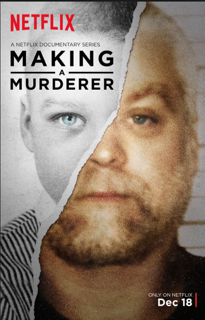Fiction, investigational series have been popular before, but now two very controversial series have emerged. By documenting legal processes and interviews of real judicial cases audiences can be taken step by step. Making a Murderer, a television series, and Serial, a listening podcast, are currently extremely popular and widely successful. Exploiting America’s trusted system one show at a time.
Netflix has made popular original television series in the past, such as Orange is the New Black, but none have come close to the ground breaking series, Making A Murderer, that has everyone captivated. Steven Avery was arrested at the age of 23 in 1985 and charged with sexual assault, attempted murder and false imprisonment. Thirty two years in prison was his sentence. The only problem was, he was falsely accused. Avery was released 18 years later on account he was not guilty proven by DNA evidence. Many viewers ask the same question; how could there be such an injustice in the law? Manitowoc Justice Department overlooked important details of the case that lead to the real criminal, Gregory Allen, and based most of the case on past petty crimes committed by Avery. All of that could be covered in an hour documentary, what the real story is, is a missing Teresa Halbach was last seen by Avery in October of 2005 and evidence of her murder is on his land. The series goes into the following proceedings of the case, and the sensitivity of the follow through based on previous wrong accusations.
In like manner of investigative programs, Serial the podcast is a huge hit. If anybody thought listening to podcasts were boring, they have not heard the Serial podcast. The first season of Serial that caught everyone’s ear is about a 1999 murder case of a high schooler that put the victim’s boyfriend (Adnan Masud Syed) in prison for 30 years. The journalist and host of Serial, Sarah Koenig, goes into detail about the murder of a woman named Hae Min Lee. Lee was missing for weeks before they found her body in Leakin Park. Syed was assumed the culprit after an anonymous call and fellow peers named him as a suspect. Though his friend even said he helped Syed bury the body, Syde claimed innocence. The podcast that was released in episodes starting in 2014, takes listeners through interviews and investigations of the case revisited years later. The interesting part is the big possibility that Syed is truly not guilty. Now on season two, Koenig explores another mysterious case that is more recognized. In 2009 in Afghanistan, a member of the US Army, Bowe Bergdahl, was captured by the Taliban. He was released in 2014. This case gained more attention by media during when the events were unraveling. Just like in season one, Serial takes the listeners step by step through the investigation.
The themes of both Making a Murderer and Serial, are finding the flaws in the justice system and how it has and can ruin innocent people’s lives with false accusations. The attention brought on by these series help the so-called “wrongly accused” through prompting interest in their cases. Syed and Avery have made appeals on their sentences. The reason these shows are so popular is due to the amount of information and how it is displayed. Cliffhangers like seeing if a man is truly guilty or new evidence that changes the case are slowly distributed through the process. Though the whole drama surrounding the shows is exciting and fun for the audience, the real people involved in the cases are benefiting too. The press and interest in the matters allow the men to have their appeals and experiences more looked at by hundreds of thousands.
As interesting and highly acclaimed both series are, these subjects do get backlash. Making a Murderer is accused of being very one sided with what information the show chooses to disclose. Serial has been criticized for the white privilege view on each case. Some listeners view the the murder of Lee and the capture of Bergdahl as adding to a racial stereotype of peoples associated with a certain religion or race to be in the center of these cases. Equally, these cases are very sensitive to deal with. Along with the attention they bring to the cases, if the reporter tell them wrong or on a certain bias to be more interesting, can cause a lot of damage to reputations (people taking care of the case, the committed, witnesses etc). The judicial system and more can easily be tarnished by a fabrication of the truth, or a race or religion can have even more against it.
Though there may be problems with how the information in the shows are presented and the content of the stories. The truth may be muddled in Making a Murderer, and races and religions being put in the same stereotype in Serial, the overall unveiling of these cases and their processes are important. The availability of the wealth of information on these unclear, tainted cases is very important.
Technology lets people from all around the world be brought along for the ride in the investigation or reinvestigation of uncertain cases. These shows are truly groundbreaking in unraveling flaws and missed evidence in filing of high charges. Hopefully the attention gained to these cases help reveal the full truth, in the meantime, keep listening and keep watching.





































